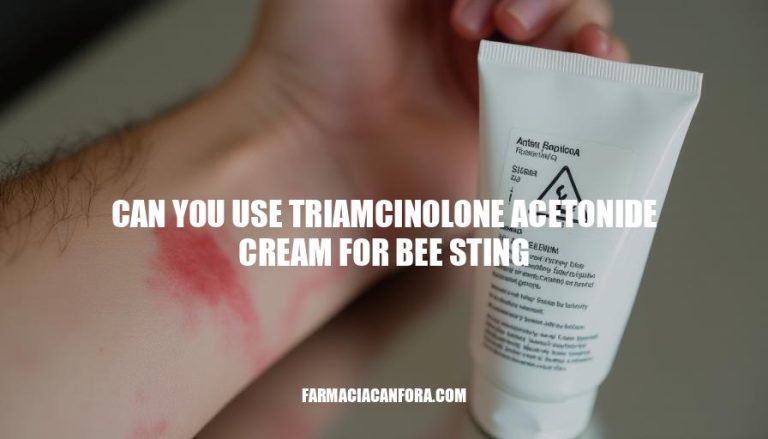


Bee stings can hurt and cause swelling, redness, and itchiness because of the venom they inject. These symptoms are usually mild and go away on their own, but sometimes you might need treatment to feel better. Triamcinolone acetonide cream is a cream that can help with inflammation and itching, but it’s not always recommended and should be used under medical guidance.
Triamcinolone acetonide cream is a topical corticosteroid that works by suppressing inflammation and immune responses in the skin. While it is effective for reducing redness, swelling, and itching associated with various dermatological conditions, its suitability for treating a bee sting is debated. Some sources suggest that local steroid application is not recommended for bee stings, while others indicate that it may help relieve itching and inflammation.
The primary concern is that bee sting reactions are often histamine-driven, and antihistamines or soothing agents like calamine lotion may be more appropriate.
Triamcinolone acetonide functions as a glucocorticoid receptor agonist, inhibiting the release of inflammatory mediators such as histamines, prostaglandins, and kinins. This suppression reduces vasodilation, capillary permeability, and immune cell activation, leading to decreased swelling, redness, and itching. The cream also has vasoconstrictive properties, which help limit fluid accumulation and irritation in the affected area.
Clean the Area – Wash the bee sting site with mild soap and water to remove any debris or venom residue.
Dry the Skin – Gently pat the area dry with a clean towel.
Apply a Thin Layer – Use a pea-sized amount of triamcinolone acetonide cream and spread it evenly over the sting site.
Massage Gently – Rub the cream into the skin until fully absorbed.
Wash Hands – After application, wash your hands thoroughly to prevent accidental transfer to sensitive areas like the eyes.
Avoid Occlusive Dressings – Do not cover the treated area with bandages unless directed by a healthcare provider.
Skin Irritation – May cause burning, itching, dryness, or redness at the application site.
Thinning of Skin – Prolonged use can lead to skin atrophy, making the area more fragile.
Systemic Absorption – Excessive application or use on large areas may result in Cushing’s syndrome-like effects, including weight gain, mood changes, and increased blood sugar levels.
Allergic Reactions – Rare but possible, including swelling, difficulty breathing, and severe irritation.
Avoid Use on Open Wounds – Do not apply to broken skin, cuts, or burns, as this increases absorption and potential side effects.
While triamcinolone acetonide cream may help alleviate itching and inflammation, antihistamines and soothing agents are generally preferred for bee sting treatment.
If symptoms persist or worsen, consult a healthcare professional to determine the best course of action. If signs of anaphylaxis (difficulty breathing, swelling of the throat, dizziness) occur, seek emergency medical attention immediately.
1www.askadoctor24x7.com2irescuebees.com3go.drugbank.com4www.medicine.com5wellwisp.com
Triamcinolone acetonide cream may provide temporary relief from itching and inflammation caused by bee stings, but its suitability for this purpose is debated.
While it can suppress inflammation and immune responses in the skin, bee sting reactions are often histamine-driven, making antihistamines or soothing agents like calamine lotion more effective alternatives.
If you do choose to use triamcinolone acetonide cream, follow proper application instructions:
However, be aware of potential side effects such as skin irritation, thinning of skin, systemic absorption, allergic reactions, and avoid using it on open wounds.
It’s essential to note that antihistamines and soothing agents are generally preferred for bee sting treatment. If symptoms persist or worsen, consult a healthcare professional to determine the best course of action.
In severe cases, seek emergency medical attention if signs of anaphylaxis occur.